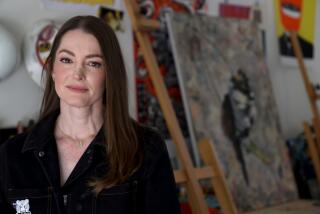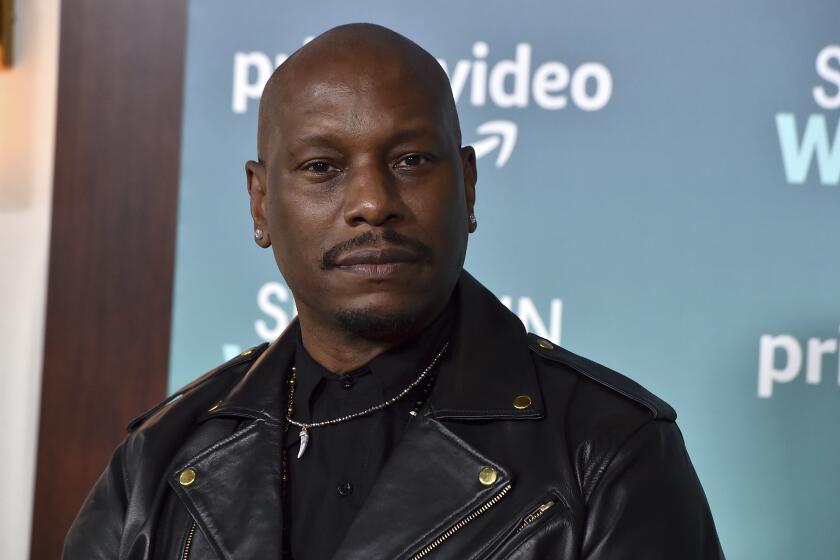Britain is Hollywood’s home away from home
LONDON — You really have to keep your eye on the British. Now they’ve stolen Brad Pitt.
Pitt, part of a British-bound diaspora of U.S. actors, directors and studio executives, is spending his autumn riding in a Sherman tank around a muddy Oxfordshire farm on the set of Sony Pictures’ World War II movie “Fury.”
Ron Howard is here, too, shooting his Nantucket-set whaling movie, “Heart of the Sea,” at a giant new studio that Warner Bros. built in a fighter plane factory in Hertfordshire. Meryl Streep, taloned and bewigged, is singing on the stages of fabled Pinewood Studios as the witch in Disney’s production of Stephen Sondheim’s “Into the Woods.” And J.J. Abrams will arrive at the same Buckinghamshire sound stages in the spring to shoot for Disney what is likely to be the most commercially ambitious film series of the next decade, the continuation of the “Star Wars” saga.
ON LOCATION: Where the cameras roll
Britain’s production scene is bustling, the byproduct of a decade’s worth of government policy promoting the industry and a robust infrastructure that grew around two of the most successful film franchises of all time, the Harry Potter and James Bond series. A generous tax incentive, sleek new sound stages and experienced, nonunion crews groomed on the Potter and Bond films have all helped to cement a new “special relationship,” one between Britain and Hollywood studios.
Indigenous English films are getting a boost, too, from tax incentives and from efforts to promote them to international buyers.
“We’ve worked to create an industrial strategy for film in the U.K,” said Adrian Wootton, chief executive of Film London and the British Film Commission, two agencies that promote production. “We’ve said, ‘Don’t think of us as the cheapest place to film. Think of us as the Rolls-Royce of places to film. You’ll get the best production, the best crew, the best visual effects, and we’ll be effective with costs. And we’ve got a tax incentive.”
The native land of David Lean and Alfred Hitchcock also holds artistic attraction for filmmakers, with its tungsten northern light, Dickensian architecture and theater-trained actors. More recently it has become home to some of the best visual effects companies in the world, including Double Negative, which worked on the Harry Potter and Batman films, and Framestore, which played a key role in “Gravity.”
“We have come to know this filmmaking locale as well as we know Los Angeles,” said Josh Berger, president of Warner Bros. U.K., the American studio doing the most business here. “We are a part of the industry here as much as we are there. We love making films here.”
PHOTOS: Billion-dollar movie club
The eastward shift of Hollywood’s biggest-budget productions has had some amusing, cross-cultural consequences. There was a nest of black widow spiders hatched in a shipment of California vintage cars destined for the London set of “Captain America: The First Avenger.”
Extravagant, American studio-style meals have arrived as well, befuddling English crews who historically had tea and sandwiches while standing around a monitor. “Spaghetti Bolognese at 11 a.m.,” said Steve Clark-Hall, a British producer of Warner Bros.’ “The Man from U.N.C.L.E.” “That was the weirdest.”
Although Britain has increased studio space 50% in the last decade, the country is getting so busy that producers are beginning to scramble for resources. On a rainy day in October, “Fury” producer Ethan Smith was working to hunt down an extra remote camera head that was in use on another set. “You have to fight for crew, for equipment, stage space, studio space, hotel rooms,” Smith said.
The 215 feature films that started shooting between January and September have spent $1.3 billion, according to Film London.
Much of the activity is due to Britain’s tax incentive, begun in 2007 and used by more than 1,000 productions. The credit, which was just expanded to include television and animation, has begun to lure high-profile TV productions, including the Fox miniseries “24: Live Another Day” and a new HBO series.
Under the incentive, productions spending more than about $32 million can claim a rebate of 20%, up to 80% of their total budget. Britain’s incentive is different from California’s in some crucial ways: It has no cap — California’s is available only to films with budgets under $75 million — and it includes above-the-line costs, such as actor, writer and director salaries, which California’s does not. On a $200-million movie, the incentive can mean a savings of more than $30 million.
PHOTOS: BAFTA Los Angeles Britannia Awards 2013
Britain joins many countries and U.S. states in this tax derby. The myriad incentives have inspired concern in Los Angeles, where Mayor Eric Garcetti, together with local union heads and Garcetti’s new film czar, Tom Sherak, are coming up with proposals for legislation.
For the British benefit, U.S. productions must pass a cultural test, accumulating points through such factors as basing a story on British subject matter, using a British visual effects company or casting actors from European Union countries.
As a result, the crew of the doomed whale ship Essex in “Heart of the Sea,” a movie about the disaster that inspired Herman Melville’s “Moby Dick,” is almost entirely played by Europeans, including Irishman Cillian Murphy and England’s Tom Holland. (Australian Chris Hemsworth plays the lead.)
“We’re making the quintessential American story, and I’m the only American in the movie,” said Georgia-born Benjamin Walker, who plays the ship’s captain and spent the better part of an October afternoon bobbing on a life raft with his cast mates at Warner Bros.’ Leavesden studios near London.
British crews have another advantage over their stateside counterparts, from a producer’s point of view: Though they belong to professional guilds, the guilds don’t set their pay rates, which are negotiated individually. They often work what are known as “French hours,” skipping a lunch break in favor of a workday that is two hours shorter, a compelling schedule in an industry in which daylight is money.
Hollywood filmmakers have a long tradition of working in Britain, mostly notably Stanley Kubrick, who moved here to shoot his 1962 film, “Lolita,” and never left, saying he found London a “very peaceful, very civilized” place to live and work. George Lucas shot the 1977 original “Star Wars” movie here as well, at Elstree Studios in Hertfordshire.
PHOTOS: Holiday movie sneaks 2013
By the early 2000s, however, British production was flagging. Wootton surveyed the international filmmaking community about its impressions of shooting in the county. “They said, ‘You’re slow. You’re expensive. You’re bureaucratic. You’re difficult. You’re unfriendly. And we shoot here despite ourselves,’” Wootton said.
With the help of key supporters in government, Britain made adjustments, adding the tax incentive in an act of Parliament in 2006, and changing laws to make roads easier to close for filming, creating a metropolitan police filming unit and opening more of the country’s landmarks to movie productions.
At the same time, the British film industry was enjoying a boost of a more magical — and privately funded — sort, the eight Harry Potter movies, all of which Warner Bros. shot at Leavesden, which it ultimately bought and spent about $150 million renovating.
The Burbank studio shows every sign of continuing its investments here. In April, at a Leavesden event attended by the duke and duchess of Cambridge and Prince Harry, Warner Bros. announced it was launching scholarships and apprenticeships to help usher young Britons into the film and television industries, making the company the single largest contributor to a British career-boosting endowment.
Like others, English director Guy Ritchie, who has made two Sherlock Holmes movies for Warner Bros. in Britain and is now at work on “The Man From U.N.C.L.E,” is noticing his home turf getting more crowded. While shooting a car chase at the Old Royal Naval College in Greenwich, which he had also used in his 2005 film, “Revolver,” and in “Sherlock Holmes,” Ritchie noted that the location has popped up in several other movies, including “The Dark Knight Rises,” “Skyfall” and “Les Miserables.”
“Maybe the novelty will wear off,” Ritchie said. “I quite like it, because I can go home at night. I don’t know who the chap is that got this going. Whoever he is, I’d like to take him out for a drink.”
More to Read
Only good movies
Get the Indie Focus newsletter, Mark Olsen's weekly guide to the world of cinema.
You may occasionally receive promotional content from the Los Angeles Times.











